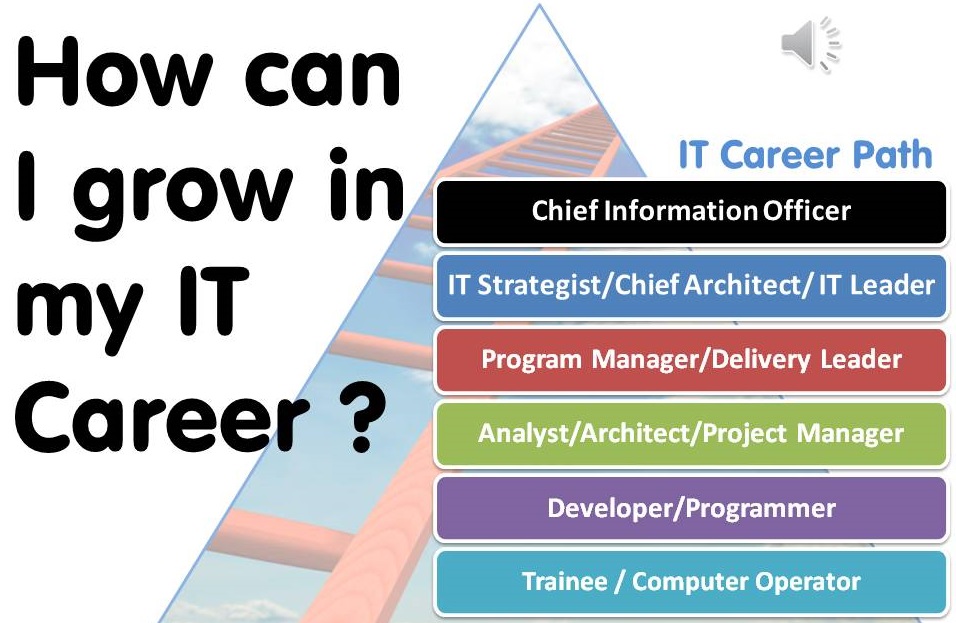- Home
- Business Processes
- Industry Knowledge
- Aerospace Industry
- Automotive Industry
- Banking Domain
- BFSI Industry
- Consumer/ FMCG Industry
- Chemicals Industry
- Engineering & Construction
- Energy Industry
- Education Domain
- Finance Domain
- Hospitality Domain
- Healthcare Industry
- Insurance Domain
- Retail Industry
- Travel and Tourism Domain
- Telecom Industry
- Leadership Skills
- eLearning
- Home
- Leadership
- Career Management
- What is a Career Path
What is a Career Path
In the early years, most jobs were skill-oriented, and with the development in lifestyles and technology, the current jobs are knowledge-oriented jobs such as management, accountants, design, or computing. Career paths encompass varied forms of career progression and this article discusses how we can build a fulfilling career? Learn here about career paths, industries, and opportunities for gaining experience in the field of your choosing.
What is Career Path?
According to the dictionary a ‘career path’ is the “way that you progress in your work, either in one job or in a series of jobs.” During the course of your career, you generally keep rising on the ‘career ladder’ where you perform a series of jobs from the lower paid job with less responsibility to the highest paid with the most responsibility within a company or particular profession. Career planning is the planning for career progression that is your plan for the process of making progress to better jobs.
Only ~30% of college graduates work in a job related to their major subjects in college. With such a low number, it’s safe to assume most people don’t know what their ideal career looks like. It can take years of doing the wrong job before you find the right fit. Day-to-day work and a company’s culture all play a part in finding the perfect career.
Types of Career Path
Career paths can basically be categorized into two broad types: one is a job-oriented career another is entrepreneur oriented career. Further, a job can be classified into two broad categories namely knowledge-oriented job and skill-oriented job. From an industry standpoint, different career paths can be divided into the following categories:
- Arts & Communication
- Business, Management, Commerce, Marketing and Technology
- Engineering, Manufacturing and Industrial Technology
- Health Sciences & Healthcare Services
- Human services
- Natural Resources and Agri-science.

Career Progression - Example
Students need to find what they are good at, but also that also needs to be something that has some demand. At the end of the day, you need to cater to the needs of the current market. Timing is very important when choosing the right career path. Career paths encompass varied forms of career progression and given below if a typical career path for software professionals. Later in the article, we will look at what professional career progression is and how to climb the career ladder effectively.
1. Early Career
When you get out of your college and decide to pursue a career in Information Technology; you start as a Trainee. Your depth of contribution is focused on your technical expertise or dynamic ability to do a particular job extremely well. You start building your breadth of contribution by building the ability to do all of the jobs in the team, to cross-train, to be flexible and you observe various skills exhibited by your seniors like leadership skills, training skills, executive skills, and motivational skills. Your sphere of influence is limited to your current team or your project.
At this stage you focus your efforts on gaining more and more knowledge about your chosen technology; and you take roles that expect you to do; code development, programming, or exhibit other technical skills; like testing or documenting.
2. Expanding Your Role
In the next stage of IT career, you broaden your technical expertise; and you start gaining depth in many technologies. Here you grow into roles demanding; technical design, technical analysis; or project implementation. At this level, you start getting exposure to project management and IT leadership concepts.
3. Growing as Manager
As a manager, you will probably oversee employees with a range of functions—accounting, policy, business development, communications—and it’s unlikely you will be an expert in all of these areas. As you grow further, professionals start expanding outside their technical domain; and learn functional and business alignment. You start becoming more accountable and; take people management & organization development roles. This is the entry-stage to senior leadership roles; demanding cross-business and cross-domain exposure. You are expected to do business development; change management; and lead many concurrent projects.
4. Senior Leadership Roles
The next levels from here take you to “IT” Leadership roles. You are expected to exhibit thought leadership in technical domains, help to set “IT” direction for a department or your business unit; and do technology selection & application. You start becoming responsible for major projects & change efforts. Your cross-business and cross-functional skills are in more demand at this stage.
5. Executive Roles
The next roles are the “CIO” or “CTO” roles that are responsible for the overall technology strategy of the entire company. You decide and manage outsourcing and vendor partnerships. You represent your organization in technical industry networks. You are expected to strategize and lead large organizational technology-driven changes. Here you are in partnership with business and generally report to the CEO of the company and need to create an IT value proposition.
Career Planning & Career Path Development
The biggest question to answer is how to plan your career so that you can move from one stage to another. How do you travel the path from stage 1 to the final stage? Given below are key skills that you can acquire to continue your career growth.
Read more about tips on moving higher in your career ladder!
“Start today creating a vision for yourself, your life, and your career. Bounce back from adversity and create what you want, rebuild and rebrand. Tell yourself it's possible along the way, have patience, and maintain peace with yourself during the process.”
― Germany Kentany
Technical Skills to Technical Leadership Career Path
It plays a major role in today’s businesses and building great software requires making decisions from the beginning to the end. The first responsibility of a technical leader is to define the technical strategy and decide on the technical direction the company should take. Technical leadership requires technical excellence, the business and technological context, and the ability to balance between speed, quality, and resource constraints.
Technical Leaders are those who excel and distinguish them as the most skilled and demanded professional who always acts with a high degree of professionalism. They are dedicated learners who are always committed to personal and professional development along-with pursuing a path of lifelong learning. They possess strategic thinking skills with the ability to link technology with business processes to provide quality advice for effective business solutions.
A strong leader must understand the technical details of the overall project and constantly guide the team to stay focused on the overall vision that the organization is trying to achieve. A technical leader must also have the skills to build a strong technical team, assign them meaningful work, and also track and understand the details of the work the team is doing.
How to Build Technical Leadership
Technical leadership requires technical skills as well as functional business process knowledge to gain a complete understanding of ever-changing business dynamics. They need to gain business know-how and enable their technical or functional abilities to work more efficiently and effectively while performing their role, which is to increase productivity, drive operational excellence, and ensure quality, providing better solutions to complex business problems and drive cost reduction in their respective areas.
If you are working in a modern End-to-End integrated IT-enabled enterprise, you need to gain a relevant skill-set, explore techno-functional opportunities, and showcase your expertise and experience more confidently. You should be able to anticipate and address the changing needs of clients, employers, customers, and markets well than any other professional that does not have technical expertise. You should gain substantial knowledge of the industry's most widely used enterprise resource planning tools and important related fields like SOX requirements, Six Sigma, Risks Controls and Governance, Audit of Systems, and can demonstrate this ability to integrate into the business decision process.
You should try to seek formal education to the foundation of key terms and all the key processes applicable to your domain, which will help you in a long way to understanding the business terminology and business needs. This when combined with your technical knowledge will help you in providing effective and efficient business solutions that will help you put your career on a fast track.
Related Links
You May Also Like
-
Emergent leadership occurs when a group member is not appointed or elected as leader, but rather that person steps up as the leader over time within-group interactions. Have you ever faced challenges in getting accepted into your new role of position as a leader? Groups don't automatically accept a new "boss" as a leader. Emergent leadership is what you must do when taking over a new group. Learn more about emergent leadership.
-
In today's business world, proficiency in management skills is essential for career growth and success. Managerial skills can be defined as attributes or abilities that are essential for every leader and manager to succeed and fulfill specific tasks expected from them by the organization.
-
Concept & Definition of Stress
Stress is a popular expression used by people in day to day life. Pressures of day to day living sometimes necessitate coping or dealing with them and stretch the body beyond its natural capacity. They are called stressors. Stress is a natural, ongoing dynamic, and interactive process that takes place as people adjust to their environment.
-
Improving Skills & Competencies
Whenever you are looking for a job or having your yearend discussion with your manager, two terms generally referred to be “Skills” and “competencies”. Today success in a career is an outcome of having essential competencies and building required skills. Skills could be a major distinguishing factor for you to move up on the career ladder and jump from one role to another. Leadership skills when combined with relevant domain and functional expertise can transform your entire career growth and help you have a fulfilling career.
-
Technology represents tremendous value if you view it from the proper perspective. IT empowerment also has its various levels in any organization. As a CIO or IT Senior Leader, you should try to move the technology function up the value chain. Learn how to transform your service delivery organization being looked upon as another cost center to a business partner that provides valuable services and brings competitive advantage for the business.
-
Tools for Developing Your Team
If a manager has too many weak spots in the talent of the team, the ability to empower the team members to independently execute the project is impaired. Assignments fall behind schedule or stretch out because the needed skills or knowledge are not in place when needed. To successfully execute important projects, hiring talented people, and increasing the talents of existing staff are most important.
-
“Level 5 Leadership”, this term was coined by Jim Collins in his book “Good to Great” and it is all about achieving "Greatness" as a leader. This article will explain what we mean by Level 5 Leadership and what the characteristics of a Level 5 leader are. What it takes to achieve greatness as a leader, and what are the steps and strategies that one can use to move up to this top level of leadership.
-
Narrative leadership is interpreted as the leader who aspires to construct leadership by telling stories. Leadership is a task of persuasion, of winning people’s minds and hearts. Storytelling is thus inherently suited for the task of leadership. Learn about the narrative leadership style and how to use this style to inspire and motivate followers or to manage change.
-
At different points in your professional career, it is helpful to identify your core values. Values are the qualities considered to be the most important guiding principles that determine the priorities in your life and greatly influence your career choices. Your career brings happiness when it is in agreement with the beliefs you have about what is important and meaningful to you. Awareness of your values will help you develop a clearer sense of what's most important to you in life.
-
Navigating your career journey will hopefully include a series of experiences that challenge your skills and abilities in ways that are satisfying and rewarding. Only you can manage your career. That means you must determine what things you are passionate about, what your goals are, both professionally and personally, and how much energy you are willing to invest along the way. Learn how to build an effective career path framework for yourself.
Explore Our Free Training Articles or
Sign Up to Start With Our eLearning Courses

About Us
Learning
© 2023 TechnoFunc, All Rights Reserved









